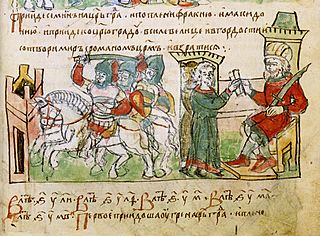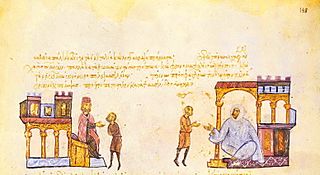Simeon I of Bulgaria facts for kids
Quick facts for kids Simeon the GreatСимеон І Велики |
|
|---|---|
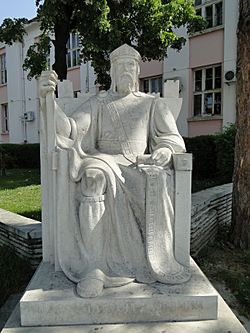
Statue of Simeon I in Vidin
|
|
| Emperor of the Bulgarians and Romans | |
| Reign | 893 – 27 May 927 |
| Predecessor | Vladimir |
| Successor | Peter I |
| Born | 864/865 |
| Died | 27 May 927 (aged 62 or 63) Preslav, Bulgaria |
| Spouse | Unknown name (first spouse) Maria Sursuvul |
| Issue | Michael Peter, Emperor of Bulgaria Ivan Benjamin |
| Dynasty | Krum's dynasty |
| Father | Boris I |
| Mother | Maria |
Tsar Simeon I the Great ruled over Bulgaria from 893 to 927. This was during the time of the First Bulgarian Empire. Simeon was a very successful leader. He led many campaigns against the Byzantines, Magyars, and Serbs.
Under Simeon, Bulgaria grew to its largest size ever. It became the most powerful country in Eastern and Southeast Europe at that time. His rule was also a time of amazing cultural growth and learning. This period is often called the Golden Age of Bulgarian culture.
During Simeon's reign, Bulgaria stretched from the Aegean Sea to the Adriatic Sea and the Black Sea. The Bulgarian Orthodox Church became independent. It was the first new patriarchate (a high-ranking church leadership) outside of the main five ancient ones. Bulgarian texts, translated into Glagolitic and Cyrillic scripts, spread across the Slavic world. The Cyrillic alphabet itself was developed at the Preslav Literary School in the 890s. Halfway through his rule, Simeon took the title of Emperor (Tsar). Before that, he was known as Prince (Knyaz).
Contents
Simeon's Early Life and Education
Simeon was born in 864 or 865. He was the third son of Prince Boris I. His father was the ruler who made Bulgaria a Christian country in 865. So, Simeon was a Christian his whole life.
Simeon's older brother, Vladimir, was supposed to become the next ruler. Boris wanted Simeon to become an important church leader, maybe even the Bulgarian archbishop. So, when Simeon was about 13 or 14, his father sent him to the famous University of Constantinople. There, he studied theology. He even took the name Simeon as a young monk in Constantinople.
He spent about ten years (around 878–888) in the Byzantine capital. He got an excellent education. He studied the speeches of famous Greek thinkers like Demosthenes and Aristotle. He also learned to speak Greek so well that some people called him "the half-Greek."
Around 888, Simeon returned to Bulgaria. He lived at the new royal monastery in Preslav. There, he worked with Naum of Preslav to translate important religious books from Greek into Old Bulgarian (now called Church Slavonic).
Meanwhile, his brother Vladimir had become the ruler after their father Boris retired to a monastery. Vladimir tried to bring back the old pagan religions. He might have even made a deal against the Byzantines with Arnulf of Carinthia. This made Boris come out of retirement. Boris had Vladimir arrested and blinded. Then, he made Simeon the new ruler. This happened at a big meeting in Preslav. At this meeting, Bulgarian was also declared the official language for the state and church. The capital was moved from Pliska to Preslav to strengthen the new Christian faith.
Simeon's Rule and Major Conflicts
Trade War and Magyar Invasions
When Simeon became ruler, the long peace with the Byzantine Empire ended. A problem started when the Byzantine Emperor Leo VI the Wise moved the market for Bulgarian goods. It was moved from Constantinople to Thessaloniki. There, Bulgarian merchants had to pay very high taxes. The Bulgarians asked Simeon for help. Simeon complained to Leo, but the emperor ignored him.
The Byzantines were busy fighting the Arabs. So, they couldn't fight Bulgaria directly. Instead, they convinced the Magyars to attack Bulgaria. They promised to help the Magyars cross the Danube River with their navy. Emperor Leo VI might have also made a deal with Arnulf. This was to make sure the Franks didn't help Simeon against the Magyars.
In 895, the Byzantines brought their forces back from southern Italy. They were led by the skilled commander Nikephoros Phokas the Elder. Simeon rushed north to stop the Magyars. He left some troops at the southern border to watch Phokas. The Byzantines offered peace, but they didn't tell Simeon about the planned Magyar attack. Simeon didn't trust them. He had the Byzantine envoy imprisoned. He also tried to block the Byzantine navy's path into the Danube.
Despite Simeon's efforts, the Byzantines helped the Magyar forces cross the Danube. The Magyars, led by Árpád's son Liüntika, then raided Bulgarian lands. Simeon went north to stop them. He fought the Magyars twice in Northern Dobruja, but the Magyars won both times. Simeon had to retreat. The Magyars plundered much of Bulgaria and reached Preslav. They then returned to their own lands. Simeon made a temporary peace with Byzantium in the summer of 895.
Fighting Back Against the Magyars
After dealing with the Magyars and Byzantines, Simeon wanted revenge on the Magyars. He made a deal with the Pechenegs, who were neighbors of the Magyars, to attack them together. He also imprisoned the Byzantine envoy Leo Choirosphaktes. This was to delay releasing Byzantine captives. He wanted to get better peace terms later.
In 896, the Magyars invaded lands of neighboring Slavs. Simeon used this as a reason for war. He attacked the Magyars with his Pecheneg allies. They completely defeated the Magyars in the Battle of Southern Buh. This forced the Magyars to leave their lands forever and settle in Pannonia. After this victory, Simeon finally released the Byzantine prisoners. In return, he got Bulgarians who were captured in 895.
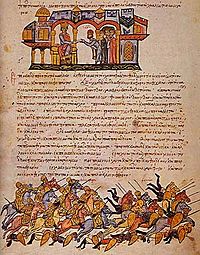
Simeon then invaded Byzantium again in the summer of 896. He claimed that not all prisoners had been released. He marched straight towards Constantinople. A Byzantine army met him in Thrace. But Simeon's forces destroyed them in the Battle of Bulgarophygon. The Byzantines were desperate. They even armed Arab captives and sent them to fight. This helped them push the Bulgarians away from Constantinople, which they had surrounded.
The war ended with a peace treaty. This treaty lasted until Leo VI's death in 912. Under this agreement, Byzantium had to pay Bulgaria money every year. The Byzantines also gave Bulgaria land between the Black Sea and Strandža. Simeon also made Serbia accept his authority. He recognized Petar Gojniković as their ruler.
Simeon often broke this peace treaty. He attacked and took Byzantine land many times. For example, in 904, Bulgarian raids helped Arabs led by Leo of Tripoli to attack and capture Thessaloniki. After the Arabs looted the city, it was easy for Bulgaria to take it. To stop Simeon from taking the city and settling it with Slavs, Leo VI had to give more land to Bulgaria in the Macedonia region. With the treaty of 904, all Slavic lands in southern Macedonia and southern Albania became part of the Bulgarian Empire. The border was set about 20 kilometers north of Thessaloniki.
Becoming Emperor
Emperor Leo VI died on May 11, 912. His young son Constantine VII became emperor. Leo's brother Alexander became the guide for the young emperor. Alexander sent away Simeon's envoys who came to renew the peace treaty. He refused to pay the yearly tribute. This made Simeon prepare for another war.
Before Simeon could attack, Alexander died on June 6, 913. The empire was left to a group of regents, led by Patriarch Nicholas Mystikos. Many people in Constantinople didn't accept the young emperor. They supported another person, Constantine Doukas. There were also revolts in southern Italy and a planned Arab invasion. All this was good for Simeon.
Patriarch Nicholas tried to stop Simeon from invading. He sent many letters. But Simeon attacked in full force in July or August 913. He reached Constantinople without much trouble.
The chaos in Constantinople ended after Constantine Doukas was killed. A new government was quickly formed with Patriarch Nicholas in charge. This made Simeon stop his siege and start peace talks. The Byzantines were happy. The talks led to Byzantium paying the money they owed. They also promised that Constantine VII would marry one of Simeon's daughters. Most importantly, Patriarch Nicholas officially recognized Simeon as the Emperor of the Bulgarians. This happened in the Blachernae Palace.
Soon after Simeon visited Constantinople, Constantine's mother Zoe returned to the palace. She quickly removed the regents. Through a plan, she took power in February 914. She removed Patriarch Nicholas from the government. She also ignored his recognition of Simeon's imperial title. She refused the planned marriage between her son and Simeon's daughter. Simeon had to go back to war to get what he wanted. He invaded Thrace in the summer of 914 and captured Adrianople. Zoe quickly sent Simeon many gifts to calm him down. She convinced him to give back Adrianople and withdraw his army. In the next few years, Simeon's armies fought in the northwestern Byzantine areas. These were around Drač (Durrës) and Thessaloniki. But they didn't attack Constantinople directly.
Great Victories at Acheloos and Katasyrtai
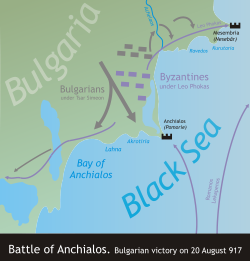
By 917, Simeon was getting ready for another war against Byzantium. He tried to make a deal with the Pechenegs to fight Byzantium together. But the Byzantines offered more money, and the Pechenegs sided with them. The Byzantines planned a huge attack on Bulgaria. They also tried to convince the Serbian Prince Petar Gojniković to attack the Bulgarians with Magyar help.
In 917, a very strong Byzantine army invaded Bulgaria. It was led by Leo Phokas the Elder. The Byzantine navy, led by Romanos Lekapenos, sailed to Bulgarian Black Sea ports. Phokas's army was going to Mesembria (Nesebǎr). They were supposed to meet the navy there. But they stopped to rest near the Acheloos, close to Anchialos (Pomorie).
When Simeon heard about the invasion, he rushed to meet the Byzantines. He attacked them from the nearby hills while they were resting. On August 20, 917, the Battle of Acheloos took place. This was one of the biggest battles in medieval history. The Bulgarians completely defeated the Byzantines. Many of their commanders were killed. Phokas managed to escape. Years later, a writer named Leo the Deacon wrote that "piles of bones can still be seen today at the river Acheloos."
The planned Pecheneg attack from the north also failed. The Pechenegs argued with Admiral Lekapenos. He refused to transport them across the Danube to help the main Byzantine army. The Byzantines also didn't get help from the Serbs and Magyars. The Magyars were busy fighting in Western Europe. The Serbs, led by Petar Gojniković, didn't attack Bulgaria. This was because Michael of Zahumlje, an ally of Bulgaria, told Simeon about their plans.
Simeon's army quickly followed up their victory at Acheloos with another success. The Bulgarians chased the remaining Byzantine army towards Constantinople. They met Byzantine forces under Leo Phokas at the village of Katasyrtai, very close to Constantinople. The Bulgarian soldiers attacked and defeated the Byzantines again. They destroyed some of their last units before returning to Bulgaria.
Dealing with Serbia and Later Wars
Right after these campaigns, Simeon wanted to punish the Serbian ruler Petar Gojniković. Petar had tried to betray him by making a deal with the Byzantines. Simeon sent an army led by his commanders, Theodore Sigrica and Marmais, to Serbia. They tricked Petar into a meeting. There, he was captured and taken to Bulgaria, where he died in prison. Simeon put Pavle Branović, who had been living in exile in Bulgaria, on the Serbian throne. This brought Serbia back under Bulgarian influence for a while.
Meanwhile, the Byzantine military failures caused another change in government in Constantinople. Admiral Romanos Lekapenos replaced Zoe as the regent for the young Constantine VII in 919. He forced Zoe back into a convent. Romanos then arranged for his daughter Helena Lekapene to marry Constantine. In December 920, he became a co-emperor. This meant he effectively took control of the empire. This was largely what Simeon had wanted to do himself.
Simeon could no longer become the Byzantine emperor through peaceful talks. So, he had to go to war again to get his way. Between 920 and 922, Bulgaria put more pressure on Byzantium. They campaigned in the west through Thessaly, reaching the Isthmus of Corinth. In the east, they reached Thrace and crossed the Dardanelles to attack Lampsacus. Simeon's forces appeared before Constantinople in 921. They demanded that Romanos be removed from power and captured Adrianople. In 922, they won a victory at Pigae. They burned much of the Golden Horn and took Bizye.
At the same time, the Byzantines tried to make Serbia rebel against Simeon. But Simeon replaced Pavle with Zaharije Pribisavljević. Zaharije was a former refugee in Constantinople whom Simeon had captured.
Simeon was desperate to conquer Constantinople. He planned a large campaign in 924. He sent envoys to the Fatimid caliph Ubayd Allah al-Mahdi Billah. The caliph had a very strong navy, which Simeon needed. The caliph agreed and sent his own representatives with the Bulgarians to arrange the alliance. However, the envoys were captured by the Byzantines in Calabria. Romanos offered peace to the Arabs. He also gave them many gifts. This ruined their alliance with Bulgaria.
In Serbia, Zaharije was convinced by the Byzantines to rebel against Simeon. Many Bulgarians, tired of Simeon's endless wars, supported Zaharije. The Bulgarian emperor sent his troops under Sigrica and Marmais. But they were defeated, and the two commanders were killed. This forced Simeon to make a truce with Byzantium. He needed to focus on stopping the uprising in Serbia. Simeon sent an army led by Časlav Klonimirović in 924 to remove Zaharije. He succeeded, and Zaharije fled to Croatia. After this victory, the Serbian nobles were invited to Bulgaria to accept the new Prince. However, they didn't show up at the meeting. All of them were killed. Bulgaria then took over Serbia directly.
In the summer of 924, Simeon still went to Constantinople. He demanded to see the patriarch and the emperor. He talked with Romanos on the Golden Horn on September 9, 924. They agreed on a truce. Byzantium would pay Bulgaria a yearly tax. In return, Bulgaria would give back some cities on the Black Sea coast. During their meeting, it is said that two eagles met in the sky. Then they flew apart, one over Constantinople and the other towards Thrace. This was seen as a sign that the two rulers would never truly be at peace. A writer named Theophanes Continuatus described this meeting. He mentioned that "the two emperors... conversed." This might mean that the Byzantines again recognized Simeon's claim to be an emperor.
War with Croatia and Simeon's Death
After Patriarch Nicholas died in 925, Simeon likely raised the status of the Bulgarian Orthodox Church to a patriarchate. This might be connected to Simeon's talks with the Papacy between 924 and 926. During these talks, he asked for and received Pope John X's recognition of his title as "Emperor of the Romans." This title was truly equal to the Byzantine emperor. He also might have gotten confirmation for the head of the Bulgarian Orthodox Church to be a patriarch.
In 926, Simeon's troops, led by Alogobotur, invaded Croatia. Croatia was an ally of Byzantium at the time. But the Croatian army, led by King Tomislav, completely defeated them in the Battle of the Bosnian Highlands. Tomislav feared Bulgarian revenge. So, he agreed to end his alliance with Byzantium and make peace. This was negotiated by a papal representative. In the last months of his life, Simeon prepared for another fight with Constantinople. Romanos desperately asked for peace.
On May 27, 927, Simeon died of heart failure in his palace in Preslav. Byzantine writers tell a legend about his death. They say Romanos cut off the head of a statue that looked like Simeon. And Simeon died at that exact moment.
His son Peter I became the next ruler. George Sursubul, Peter's uncle, was initially the regent. As part of a peace treaty signed in October 927, Peter married Romanos's granddaughter, Maria (Eirene). The existing borders were confirmed. Also, the Bulgarian ruler's imperial title and the head of the Bulgarian Church's patriarchal status were officially recognized.
Historian H.H.Howorth believed that if Simeon had lived longer, or if his successors were as strong as him, a large Slavic state might have formed. This state would have stretched from the Adriatic to the Black Sea. It could have been a barrier against the Turks later on.
Culture and Religion Under Simeon
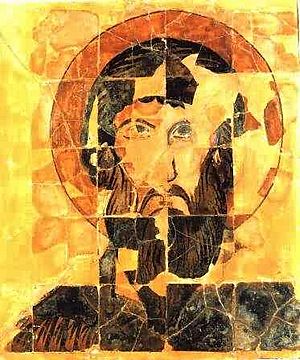
During Simeon's rule, Bulgaria reached its highest point culturally. It became the main center for literature and spirituality in Slavic Europe. Simeon continued his father Boris's work. He kept building and spreading Slavic culture. He also brought famous scholars and writers to Bulgaria.
The late 9th and early 10th centuries were the most active time for medieval Bulgarian literature. This work was mainly done at the Preslav Literary School and Ohrid Literary School. These schools were founded by Boris. During Simeon's reign, they focused on creating works in the new Cyrillic alphabet.
Simeon spent his early years in Constantinople. He brought Byzantine culture to the Bulgarian court. But he made sure it didn't take over Bulgarian identity. He did this through military power and religious independence. The students of Cyril and Methodius, like Clement of Ohrid, Naum, and Constantine of Preslav, continued their teaching in Bulgaria. They actively translated Christian texts into Bulgarian. These included the Bible and works by important church leaders. They also translated historical writings.
Simeon's time also saw many new religious and non-religious works written. Examples include John Exarch's Six Days and Constantine of Preslav's Alphabetical Prayer. Černorizec Hrabǎr wrote An Account of Letters. People at the time praised Simeon's own contributions to this literary boom. For example, the Praise to Tsar Simeon and Simeon's Collection mention his work. The tsar even added his own writings to Simeon's Collection.
Simeon made the new Bulgarian capital, Preslav, a magnificent religious and cultural center. It was meant to show off his empire's greatness and serve as a royal home. Preslav had over twenty cross-domed churches and many monasteries. It also had an impressive royal palace and the Golden (or Round) Church. Preslav truly became an imperial capital. The art of this period is shown by a ceramic icon of Theodore Stratelates and the unique Preslav-style decorated ceramics.
Simeon's Family
Simeon was married twice. His first wife's name is not known. They had a son named Michael. Michael was not chosen to be the next ruler. This might have been because his mother was not from a high-ranking family. He was sent to a monastery.
His second wife was the sister of a powerful noble, George Sursubul. They had three sons:
- Peter: He became Emperor of Bulgaria in 927 and ruled until 969.
- Ivan: He tried to plot against Peter in 929 but failed. He then fled to Byzantium.
- Benjamin (Bajan): A historian named Liutprand of Cremona wrote that Benjamin "could suddenly turn himself into a wolf or other strange animal."
Simeon also had several daughters. One of them was supposed to marry Constantine VII in 913. But Constantine's mother Zoe canceled the marriage when she returned to the court.
| Family tree of Simeon I | ||||||||||||||||||||||||||||||||||||||||||||||||||||||||||||||||||||||||||||||||||||||||||||||||||||||||||||||||||||||||||||||||||||
|---|---|---|---|---|---|---|---|---|---|---|---|---|---|---|---|---|---|---|---|---|---|---|---|---|---|---|---|---|---|---|---|---|---|---|---|---|---|---|---|---|---|---|---|---|---|---|---|---|---|---|---|---|---|---|---|---|---|---|---|---|---|---|---|---|---|---|---|---|---|---|---|---|---|---|---|---|---|---|---|---|---|---|---|---|---|---|---|---|---|---|---|---|---|---|---|---|---|---|---|---|---|---|---|---|---|---|---|---|---|---|---|---|---|---|---|---|---|---|---|---|---|---|---|---|---|---|---|---|---|---|---|---|
|
||||||||||||||||||||||||||||||||||||||||||||||||||||||||||||||||||||||||||||||||||||||||||||||||||||||||||||||||||||||||||||||||||||
Simeon's Legacy and Popular Culture
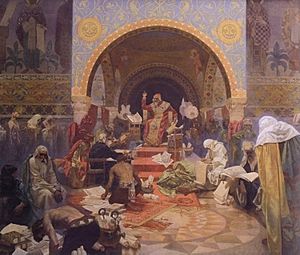
Tsar Simeon I is still one of the most respected figures in Bulgarian history. In a TV show called Velikite Bǎlgari (like "100 Greatest Britons"), he was voted the fourth greatest Bulgarian ever in 2007.
Simeon the Great has often appeared in stories and art. The famous Bulgarian writer Ivan Vazov wrote a patriotic poem for children about him, called "Tsar Simeon." This poem was later turned into a song, "Kray Bosfora šum se vdiga" ("A Clamour Rises by the Bosphorus").
An 11-episode TV drama series, Zlatniyat vek (The Golden Age), was made in 1984. It tells the story of Simeon's reign. The painting "The Bulgarian Tsar Simeon" is part of the 20-canvas work by Alfons Mucha, called The Slav Epic.
The last Bulgarian monarch, Simeon Saxe-Coburg-Gotha, was named after Simeon I. A high-quality grape rakija (a type of brandy) called Car Simeon Veliki also carries his name. An Antarctic peak on Livingston Island was named Simeon Peak in his honor.
Timeline
| Timeline of Simeon I's life |
|---|
 |
See also
 In Spanish: Simeón I de Bulgaria para niños
In Spanish: Simeón I de Bulgaria para niños



